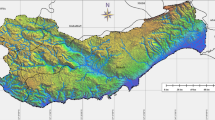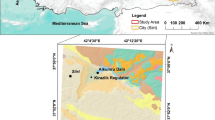Abstract
Landslide risk was assessed at the basin scale, in terms of specific landslide risk, in a region with limited information on landslide occurrence. Specific landslide risk was mapped by combining the landslide-hazard map and vulnerability of the elements at risk. The assessment of landslide hazard was based both on the spatial-temporal probability of landslide occurrence and on landslide intensity. In this regard, a major problem to resolve was the landslide-occurrence probability. Thus, several procedures were performed, including remote-sensing-based techniques, photointerpretation, dendrochronology, and press news. On the other hand, vulnerability was studied based empirically on the inferred relationship between the hazard class and the likely damage that the landslide would cause. In this way, vulnerability was shown in terms of expected degree of loss by using property-loss criteria. The results reveal that specific landslide risk in the area is mainly low, since just 2.26% of zone showed either a possible or a likely specific landslide risk. Buildings, irrigation structures, and main roads cover 2.6% of the study zone while representing approximately 80% of the specific landslide risk. By contrast, croplands cover almost 50% of the area but represent only 7.1% of specific landslide risk. The results indicate that, although this empirical methodology is subject to some level of uncertainty, it can provide reasonable estimates of specific landslide risk over a large area despite lacking information on landslide occurrence.



Similar content being viewed by others
References
AGS (2007) Guideline for landslide susceptibility, hazard and risk zoning for land use planning. Aust Geomech 42(1):12–36
Bertolini G, Guida M, Pizziolo M (2005) Landslides in Emilia-Romagna region (Italy): strategies for hazard assessment and risk management. Landslides 2(4):302–312
Brabb EE (1991) The world landslide problem. Episodes 14(1):52–61
Capitani M, Ribolini A, Bini M (2013) The slope aspect: a predisposing factor for landsliding? Compt Rendus Geosci 345(11–12):427–438
Cardinali M, Reichenbach P, Guzetti F, Ardizzone F, Antonini G, Galli M, Cacciano M, Castellani M, Salvati P (2002) A geomorphological approach to the estimation of landslide hazards and risks in Umbria, Central Italy. Nat Hazards Earth Syst Sci 2(1–2):57–72
Carrara A, Cardinali M, Detti R, Guzzetti F, Pasqui V, Reichenbach P (1991) GIS techniques and statistical models in evaluating landslide hazard. Earth Surf Process Landf 16(5):427–445
Carrara A, Crosta GB, Frattini P (2003) Geomorphological and historical data in assessing landslide hazard. Earth Surf Process Landf 28(10):1125–1142
Chung C-JF, Fabbri AG (2003) Validation of spatial prediction models for landslide hazard mapping. Nat Hazards 30(3):451–472
Corominas J, Moya J (2008) A review of assessing landslide frequency for hazard zoning purposes. Eng Geol 102(3–4):193–213
Costanzo D, Rotigliano E, Irigaray C et al (2012) Factors selection in landslide susceptibility modelling on large scale following the GIS matrix method: application to the river Beiro basin (Spain). Nat Hazards Earth Syst Sci 12(2):327–340
Cruden DM, Varnes DJ (1996) Landslides types and processes. In: Turner AK, Schuster RL (eds) Landslides: investigation and mitigation. National Academic Press Sp-Rep 247, Washington DC, pp 35–76
Dai FC, Lee CF, Ngai YY (2002) Landslide risk assessment and management: an overview. Eng Geol 64(1):65–87
Fell R (1994) Landslide risk assessment and acceptable risk. Can Geotech J 31(2):261–272
Fell R, Corominas J, Bonnard C, Cascini L, Leroi E, Savage WZ, on behalf of the JTC-1 Joint Technical Committee on Landslides and Engineered Slopes (2008) Guidelines for landslide susceptibility, hazard and risk zoning for land-use planning. Eng Geol 102(3–4):85–98
Fernández T, Irigaray C, El Hamdouni R, Chacón J (2003) Methodology for landslide susceptibility mapping by means of a GIS. Application to the Contraviesa area (Granada, Spain). Nat Hazards 30(3):297–308
Fernández P, Irigaray C, Jiménez-Perálvarez JD, El Hamdouni R, Crosetto M, Monserrat O, Chacon J (2009) First delimitation of areas affected by ground deformations in the Guadalfeo River Valley and Granada metropolitan area (Spain) using the DInSAR technique. Eng Geol 105(1–2):84–101
Fernández T, Jiménez-Perálvarez JD, Delgado J, Cardenal J, Pérez JL, El Hamdouni R, Irigaray C, Chacón J (2013) Methodology for landslide susceptibility and hazard mapping using GIS and SDI. In: Zlatanova S, Peters R, Dilo A, Scholten H (eds) Intelligent systems for crisis management, vol 1. Springer, Berlin, pp 185–198
Fernández T, Pérez JL, Colomo C, Cardenal J, Delgado J, Palenzuela JA, Irigaray C, Chacón J (2017) Assessment of the evolution of a landslide using digital photogrammetry and LiDAR techniques in the Alpujarras region (Granada, southeastern Spain). Geosciences 7(2):32 23p
Glade T, Anderson MG, Crozier MJ (eds) (2005) Landslide hazard and risk. John Wiley & Sons, Chichester. 824p. https://doi.org/10.1002/9780470012659
Gómez-Pugnaire MT, Galindo-Zaldívar J, Rubatto D, Gonzalez-Lodeiro F, Lopez Sanchez-Vizcaino V, Jabaloy A (2004) A reinterpretation of the Nevado-Filábride and Alpujárride complexes (Betic Cordillera): field, petrography and U-Pb ages from orthogneisses (western Sierra Nevada, S Spain). Schweiz Miner Petrogr Mitt 84(3):303–322
Goodchild MF (1986) Spatial autocorrelation. CATMOG 47. Geo Books, Norwich 56p
Guzzetti F, Reichenbach P, Cardinali M, Galli M, Ardizzone F (2005) Probabilistic landslide hazard assessment at the basin scale. Geomorphology 72(1–4):272–299
Guzzetti F, Mondini AC, Cardinali M, Fiorucci F, Santangelo M, Chang KT (2012) Landslide inventory maps: new tools for an old problem. Earth-Sci Rev 112(1–2):42–66
Haque U, Blum P, da Silva PF and 19 more (2016) Fatal landslides in Europe. Landslides 13(6):1545–1554
Hungr O, Leroueil S, Picarelli L (2014) The Varnes classification of landslide types, an update. Landslides 11(2):167–194
Irigaray C, Fernández T, El Hamdouni R, Chacón J (2007) Evaluation and validation of landslide-susceptibility maps obtained by a GIS matrix method: examples from the Betic Cordillera (southern Spain). Nat Hazards 41(1):61–79
Jenks GF (1967) The data model concept in statistical mapping. Int Yearb Cartogr 7:186–190
Jiménez-Perálvarez JD, Irigaray C, El Hamdouni R, Chacón J (2011) Landslide-susceptibility mapping in a semi-arid mountain environment: an example from the southern slopes of Sierra Nevada (Granada, Spain). Bull Eng Geol Environ 70(2):265–277
Jiménez-Perálvarez JD, El Hamdouni R, Palenzuela JA, Irigaray C, Chacón J (2017) Landslide-hazard mapping through multi-technique activity assessment: an example from the Betic Cordillera (southern Spain). Landslides Online First: 17p. Published online: 11 June 2017. https://doi.org/10.1007/s10346-017-0851-6
Margottini C, Vilímek V (2014) The ICL Network on “Landslides and Cultural & Natural Heritage (LACUNHEN)”. Landslides 11(5):933–938
Martelloni G, Segoni S, Fanti R, Catani F (2012) Rainfall thresholds for the forecasting of landslide occurrence at regional scale. Landslides 9(4):485–495
Palenzuela JA, Jiménez-Perálvarez JD, El Hamdouni R, Alameda-Hernández P, Chacón J, Irigaray C (2016) Integration of LiDAR data for the assessment of activity in diachronic landslides: a case study in the Betic Cordillera (Spain). Landslides 13(4):629–642
Pellicani R, Van Westen C, Spilotro G (2014) Assessing landslide exposure in areas with limited landslide information. Landslides 11(3):463–480
Remondo J, Bonachea J, Cendrero A (2005) A statistical approach to landslide risk modelling at basin scale: from landslide susceptibility to quantitative risk assessment. Landslides 2(4):321–328
Rodríguez Peces MJ (2010) Analysis of earthquake-triggered landslides in the South of Iberia: testing the use of the Newmark’s method at different scales. PhD Thesis, Department of Geodynamics University of Granada, Granada, 254p
Rotigliano E, Cappadonia C, Conoscenti C, Costanzo D, Agnesi V (2012) Slope units-based flow susceptibility model: using validation tests to select controlling factors. Nat Hazards 61(1):143–153
SafeLand (2011) Guidelines for landslide susceptibility, hazard and risk assessment and zoning. In: EU-FP7 SafeLand project (ed) Living with landslide risk in Europe: assessment, effects of global change, and risk management strategies, Deliverable D2.4, 173p
UNESCO (2017) The list of the World heritage sites http://whc.unesco.org/en/list/. Accessed 20 January 2017
United Nations (2017) Department of Economic and Social Affairs—Population Division http://www.un.org/en/development/desa/population. Accessed 20 January 2017
Uzielli M, Catani F, Tofani V, Casagli N (2015) Risk analysis for the Ancona landslide—II: estimation of risk to buildings. Landslides 12(1):83–100
Van Den Eeckhaut M, Hervás J (2012) State of the art of national landslide databases in Europe and their potential for assessing landslide susceptibility, hazard and risk. Geomorphology 139(140):545–558
Van Westen CJ (2000) The modelling of landslide hazards using GIS. Surv Geophys 21(2):241–255
Van Westen CJ, Van Asch TW, Soeters R (2006) Landslide hazard and risk zonation—why is it still so difficult? Bull Eng Geol Environ 65(2):167–184
Varnes DJ (1984) Landslide hazard zonation: a review of principles and practice. Commission on Landslides of the IAEG, UNESCO, Paris. Natural Hazards Series 3, 63p
Vranken L, Vantilt G, Van Den Eeckhaut M, Vandekerckhove L, Poesen J (2015) Landslide risk assessment in a densely populated hilly area. Landslides 12(4):787–798
Wieczoreck GF (1996) Landslide triggering mechanisms. In: Turner AK, Schuster RL (eds) Landslides: investigation and mitigation. National Academic Press Sp-Rep 247, Washington DC, pp 77–90
WP/WLI (1993) A suggested method for describing the activity of a landslide. International Geotechnical Societies’ UNESCO Working Party on World Landslide Inventory. Bull Eng Geol Environ 47(1):53–57
Acknowledgements
Rainfall data was supplied by the Andalusian Environmental Information Network. Earthquake data was supplied by the Andalusian Institute of Geophysics belonging to the University of Granada. Author is thankful to both the editor and two anonymous referees for their constructive suggestions and comments.
Author information
Authors and Affiliations
Corresponding author
Rights and permissions
About this article
Cite this article
Jiménez-Perálvarez, J.D. Landslide-risk mapping in a developing hilly area with limited information on landslide occurrence. Landslides 15, 741–752 (2018). https://doi.org/10.1007/s10346-017-0903-y
Received:
Accepted:
Published:
Issue Date:
DOI: https://doi.org/10.1007/s10346-017-0903-y




